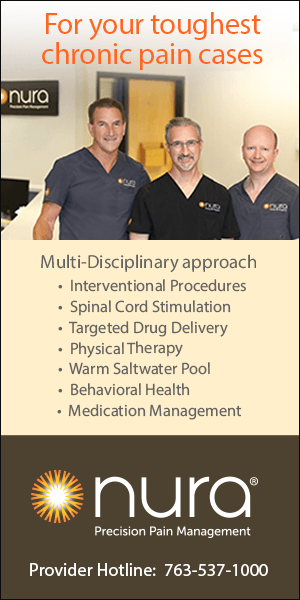acked within the Omnibus Commerce Bill, Minnesota recently passed legislation enacting a Prescription Drug Affordability Board (the Board) that lets PBMs off the hook. The Board will do little to help patients and will likely harm future access to medicines. It is a bad deal for Minnesotans and it threatens the patient-doctor relationship, while injecting bureaucrats into the evaluation of whether certain treatments are worth paying for. It also does nothing to stop health insurance plans and their PBMs from making patients pay more for medicines than they do.
cover story two
A Missed Opportunity
The Prescription Drug Affordability Board
BY Reid Porter
Instead of risking access to medicines and future cures, Minnesota legislators should be focusing on stopping the tactics insurers and PBMs use to keep patients from getting the lifesaving treatments they need.
The Board has created strong concerns among oncologists, who regularly administer prescriptions in a clinical setting, that it could reduce patient access to breakthrough therapies while adding to difficulties in providing community cancer care, as well as treating rare diseases and other serious illness. Also, it will disproportionately increase costs to independent providers. This concern was not addressed by legislators, and many physicians in Minnesota remain concerned with how the Board will impact access to critical treatments.
More than half of every dollar spent on a brand medicine goes to middlemen.
Price Controls Limit Medication Access
Research shows that it is simply not true that government can impose significant price controls without damaging the chances for future cures. The Center for Life Sciences Innovation Information Technology and Innovation Foundation was established in 2006. It is an independent 501(c)(3) nonprofit, nonpartisan research and educational institute. It has been recognized repeatedly as the world’s leading think tank for science and technology policy. In a 2019 report, they noted academic studies consistently show a reduction in current drug revenues leads to a fall in future research and the number of new drug discoveries. Policymakers need to keep this cost in mind when setting any policies that affect drug revenues.
A 50 percent decrease in the price of medicines would result in a 25 to 60 percent decrease in the number of new drugs in the pipeline, according to expert estimates. U.S. patients enjoy earlier and less restrictive access to new therapies, a finding that is reinforced by HHS’s own analysis of Medicare Part B drugs, which showed that only 11 of the 27 drugs examined (41percent) were available in all 16 comparator countries, nearly all of which have policies that let the government set the price for medicines.
Nearly 90 percent of new medicines were available within one year of launch in the U.S., compared to just 52 percent in France, 45 percent in Canada and 61 percent in Germany – according to data capturing all 460 new medicines launched between 2012 and the end of 2021. In countries where governments set the price for medicines, such as the United Kingdom, it can take over a year from the time a drug is approved to the time it is available to patients. Some countries have a delay of over three years for a cancer drug to be available to patients.
Biopharmaceutical companies remain committed to research and development, but government price controls at the federal level are already forcing the industry to make hard choices when it comes to investments in research and development (R&D). In fact, a recent survey of major pharmaceutical manufacturers showed that, when asked if they expect to shift R&D investment focus away from small molecule medicines because of the federal Inflation Reduction Act (IRA), 63 percent of those who responded to the question said yes. Now, even before the IRA is fully implemented, Minnesota is piling on.
For companies with pipeline projects in cardiovascular, mental health, neurology, infectious disease, cancers and rare diseases, 82 percent, or more, expect “substantial impacts” on R&D decisions in these areas.
Disturbing Facts
The prices health plans paid for brand medicines increased by an average of just 1.0% in 2021 due to negotiations in the market. It often doesn’t feel that way for patients because insurers and pharmacy benefit managers (PBMs) have increasingly shifted more out of pocket costs on medicines to many patients through high deductibles and coinsurance. So while health plans routinely base patient cost sharing for services like hospital stays and doctor visits on negotiated prices the health plans pay, when it comes to life saving medicines, patients often do not receive these discounts.
More than half of every dollar spent on a brand medicine goes to middlemen like insurance companies and PBMs, as well as hospitals and the government. Just three PBMs control 80 percent of the marketplace, which means they get to decide what medicines are covered and what patients have to pay. More often than not, these middlemen put their own profits before patients.
Three PBMs control 80% of the prescription drug market, and they own or are owned by health insurance companies.
What Minnesotans Are Saying
A new 50-state poll conducted by Morning Consult found that 87 percent of Minnesotans agree lowering out-of-pocket costs for health care should be a top policy priority for policymakers. A similar majority of Americans in all 50 states support common sense solutions that would help patients pay less for their medicines and provide better oversight of middlemen. Among the most popular solutions for lowering drug prices is ensuring that patients don’t pay more for their medicine than health insurance companies or pharmacy benefit managers (PBMs).
Further findings showed 83 percent of Minnesotans agree lawmakers should require health insurance companies and their middlemen to pass the rebates and discounts they receive directly to patients.
Policy makers need to accurately diagnose the root causes of high prescription drug costs and consider survey solutions. There included:
- Ensuring health insurance companies and middlemen are held accountable for their role in creating barriers between patients and the medicines they need.
- Requiring all health insurance plans to cover certain medications used to treat chronic conditions from day one of the plan year.
- Requiring health insurance companies to count patient assistance, such as cost sharing assistance, toward the patient’s deductibles.
- Requiring health insurance companies to cover medicines from day one by offering at least some health plan options that exclude medicines from deductibles and only charge set copay amounts.
- Capping the amount of cost sharing, such as deductibles and coinsurance, that patients pay out-of-pocket for their medicines.
Initiative Failings
The Board fails to address the challenges created by massive consolidation and vertical integration in the health insurance and PBM industry. Currently, only three PBMs control 80% of the prescription drug market, and they own or are owned by health insurance companies, giving these entities unchecked ability to siphon huge profits out of the health care system.
Scott LaGanga, senior vice president of state advocacy for PhRMA recently noted, “ Patients need help affording their medicines at the pharmacy counter, which is why we have consistently supported a number of policies that will directly address this need. Unfortunately, there’s no evidence the prescription board will solve these problems. Instead, Minnesota should follow the lead of other states that have found ways to save patients money.”
Minnesotan’s need help with their out-of-pocket costs for prescription drugs and there are many policies that other states have passed or are considering to help ensure rebates reach patients at the pharmacy counter, and that patient assistance programs count towards patient deductibles. Policymakers looking for ways to lower costs for Minnesotan’s should be focusing on policies that help patients better afford their medicines at the pharmacy counter.
One way to reign in PBMs and lower costs for patients is by requiring PBMs to make sure the out-of-pocket costs patients pay is based on the lower price the PBM pays. Recently, West Virginia became the first state to pass legislation of this kind to help patients save money at the pharmacy counter. Minnesota’s legislature could pass similar legislation to make a big difference for patients in the very near future.
Policies such as making cost-sharing assistance count towards a patient’s out-of-pocket spending requirements, making monthly costs more predictable and requiring that coverage for some medicines starts from day one would also lower costs for patients without sacrificing access to medicines.
PhRMA and its member companies share the concern that many patients face challenges affording their medicines at the pharmacy. We want to work with the state’s legislature on solutions. Minnesota’s Prescription Drug Affordability Board won’t achieve our shared goal of improving affordability and protecting Minnesotans’ access to the medicines they need.
Reid Porter is the senior director, state relations, public affairs for the Pharmaceutical Research and Manufacturers of America (PhRMA).
MORE STORIES IN THIS ISSUE
cover story one
Health Care Utilization: Finding the right balance
By Zeke McKinney, MD, MHI, MPH
cover story two
A Missed Opportunity: The Prescription Drug Affordability Board



















